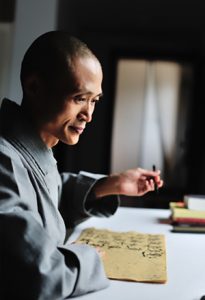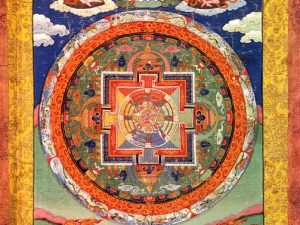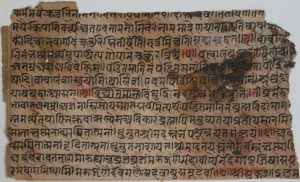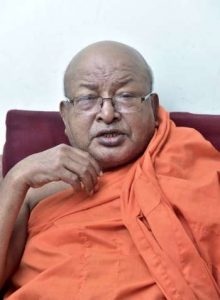
In Theravada lies a fascinating contemporary contradiction. On one hand, Theravada Buddhists, with some justification, maintain that the overall tradition of Theravada is the oldest extant transmission of Buddhism. On the other, modern Theravada (as a practice distinct from the Pali Canon) is actually a relatively modern movement by the very virtue of understanding itself as something older and more authentic than other expressions of Buddhism (specifically, the various Mahayana and Vajrayana schools). As Prof. Kate Crosby challenges in her new book Esoteric Theravada: The Story of the Forgotten Meditation Tradition of Southeast Asia, when was the last time readers really encountered an in-depth study on pre-modern Theravada practices in Southeast Asia? In this seminal book, Crosby introduces to a broader audience borān kammaṭṭhāna, the “old meditation” that was established and promoted by royalty and by the supreme patriarchs of the Buddhist sangha in the regions that would become Cambodia, Laos, Sri Lanka, and Thailand. (173–74) It is anything but a simple school of meditation, and far beyond what conventional coverage has cast for decades as simply being a dichotomy of samatha and vipassana. The historical borān kammaṭṭhāna is a phenomenon that preceded this dichotomy and, in many ways, united both practices.
I first encountered Dr. Crosby’s work on Southeast Asian Buddhism during my time at the School of Oriental and African Studies more than a decade ago. The Buddhist Studies department’s focus on Buddhist history and languages might not be for those who view Buddhism as a living tradition rather than a relic of fascination for Western-trained scholars, yet this is a significant misunderstanding or misframing of the critical historical project advocated by these scholars. It is through history that Crosby offers something truly new and valuable in this book: a historically based critique of the modern construction of Theravada practiced today. Her monograph provides a comprehensive genealogy of the Theravada tradition, first setting the scene for why borān kammaṭṭhāna has been overlooked since the colonial period in Southeast Asia, and then offering an analysis of how it developed from the Abhidhamma to being disseminated through grammar, meditation, and royal patronage.
There have been antecedents to studies of borān kammaṭṭhāna. Crosby uses “esoteric Theravada.” An earlier study by Lance Cousins uses “Southern Esoteric Buddhism,” specifically: “a type of Southern Buddhism which links magical and ritual practices to a theoretical systematization of the Buddhist path itself.” (190) Crosby notes that, “borān kammaṭṭhāna describes itself as system of samatha-vipassanā meditation, in other words, a meditation system that achieves both the samatha and vipassanā outcomes, so the full Buddhist path, as found also in the Visuddhimagga.” (42)
The book is comprehensive and divided into seven chapters: “The Colonial Gaze: The Invisibility of Pre-Modern Theravada Meditation,” “Abhidhamma and Practice: The Path in Theravada Meditation Systems,” “Documenting the Esoteric: The Production and Survival of Evidence for Borān Kammaṭṭhāna Meditation,” “Technologies of Transformation: Grammar, Mathematics, and the Significance of Substitution,” “Transformation of the Body: Meditation, Medicine, and Chemistry,” “From Center to Periphery: The Changing Place of Borān Kammaṭṭhāna under Thai Influence,” and “Meditation in Modern Revivals.” As indicated, borān kammaṭṭhāna is a comprehensive program of practice that has had a long history in Southeast Asia, with textual and material evidence datable to the 18th century and the 16th century, respectively—of which the latter, as Dr. Crosby observes, is about as old as it gets for surviving Theravada (74).
A detailed meditation process is described in Skilton and Choompolpaisal’s article on anapanasati, preserved by a branch of borān kammaṭṭhāna called Kammatthan Majjima Baeb Lamdub (by the authors’ own admission, this is not a definitive description due to the phenomenon’s complexity and the severe lack of scholarly material). This was taught by the fourth Rattanakosin sangharat (Thai; Pali: saṅgharāja; Supreme Patriarch), Suk Kaitheun (Somdet Yannasangvorn, 1733–1822) (Skilton and Choompolpaisal, 2015, 208). By Dr. Crosby’s admission, physical and textual evidence for this tradition is scattered through various sources in the Theravada world (paper and palm-leaf manuscripts) that do not fit easily into a single category of a borān kammaṭṭhāna text. The Nevill collection in the British Library contains a significant number of manuscripts that can be identified as hailing from this tradition. (83)
Dr. Crosby lays out the construction of modern Theravada (at the expense of borān kammaṭṭhāna) as follows:
In the revivals of the nineteenth and early twentieth centuries, Buddhist meditation focused on insight and the development of the mind, rather than on physical transformation. . . . This selectiveness facilitated the later uptake and adaptation of these forms of meditation in the West, when Buddhist meditation practices were increasingly adopted by Westerners. This, in turn, informed scientific developments in the newly developing fields of cognitive science and psychology, including therapy. . . .
This history begs two questions. (1) What happened to the forms of meditation that were still practiced in the nineteenth and early twentieth centuries, at least in those parts of the Theravada world not colonized by the British? (2) Given that meditation within Theravada Buddhism itself was not new—even if its teaching en masse in centers specially constructed for the purpose was a new departure—and given that science is in itself a culturally constructed approach to knowledge, what was the relationship between meditation and ‘science’ (or its analogous cultural counterparts) before these new developments? (20–21)
Dr. Crosby challenges scholarly and popular conceptions of Theravada, which she argues have been blinkered by a profound lack of scholarship on pre-modern Theravada meditation. The book spends significant space unpacking the reasons behind the marginalization of this tradition in the context of European colonialism and the modernist revival of Theravada, which took on the concerns of science and rationalism in order to compete with an increasingly materialist and Christian-tinted zeitgeist propagated by the ruling European and local elite:
Why . . . has borān kammaṭṭhāna been so negatively assessed? Why has it remained relatively unknown, even among scholars of Buddhism? Its neglect in scholarship reflects two things: its esoteric nature and its marginalization as “unorthodox” within the reform-oriented Buddhism that dominated Sri Lanka and mainland Southeast Asia from the nineteenth century onward. (26)
Colonialism and shifting zeitgeists were not the only factors that led to the decline of borān kammaṭṭhāna in Southeast Asia. Dr. Crosby provides a comprehensive, detailed analysis of the local treatment of borān kammaṭṭhāna in unique national contexts—in particular, Chapter six (“From Center to Periphery: The Changing Place of Borān Kammaṭṭhāna under Thai Influence”) and Chapter seven (“Meditation in Modern Revivals”). Chapter six explains how various trends, such as the modernization and centralization policies of the Chakri dynasty and the creation of the modern Thai nation-state, and decisions made by influential figures such as Prince Wachirayan (186–89), led to the decline and even suppression of borān kammaṭṭhāna. Reforms in Thailand influenced developments in French-administered Cambodia, culminating in a royal reformist edict in December 1920 that crippled the traditional ways. (195–98)
Chapter seven highlights attempts at reviving borān kammaṭṭhāna. This was hampered in no small part by considerable national traumas that overtook Southeast Asia, such as the Khmer Rouge’s purges of religious institutions and clergy. Corresponding, detailed accounts are given for Sri Lanka and modern-day Myanmar, and Dr. Crosby excels in providing comprehensive yet compact explanations of each country’s situation. (233–34)
Dr. Crosby’s book is unique; for years the study of Theravada in the pre-modern world has been overlooked by scholarship of pre-modern Mahayana Buddhism. The paucity of primary and secondary resources did not help. There are also whiffs of a certain “prestige” bias when it comes to the number of journals and monographs focused on Mahayana history before the contemporary period, while pre-modern Theravada—before it became “arranged” or “organized” into the neat categories of vipassana and samatha in the 20th century—has not enjoyed the same coverage. In a sense, Mahayana history, particularly in China, Japan, and on the Korean Peninsula, has been far better documented than traditional Theravada. Dr. Crosby’s Esoteric Theravada is a welcome corrective and more will surely come, building on her research.
References
Kate Crosby. 2021. Esoteric Theravada: The Story of the Forgotten Meditation Tradition of Southeast Asia. Boulder, Colorado: Shambhala.
Lance Cousins. 1997. “Aspects of Esoteric Southern Buddhism,” in Indian Insights: Buddhism, Brahmanism, and Bhakti. Luzac Oriental London, pp. 185–207. Accessed at: https://www.academia.edu/1417358/Aspects_of_Esoteric_Southern_Buddhism.
Andrew Skilton and Phibul Choompolpaisal. 2015. “The Ancient Theravāda Meditation System, Borān Kammaṭṭhāna: Ānāpānasati or ‘Mindfulness of The Breath’ in Kammatthan Majjima Baeb Lamdub,” in Buddhist Studies Review 32.2. Accessed at: https://journals.equinoxpub.com/BSR/article/view/28172/pdf
See more
Esoteric Theravada: The Story of the Forgotten Meditation Tradition of Southeast Asia (Shambhala)
Related features from Buddhistdoor Global












